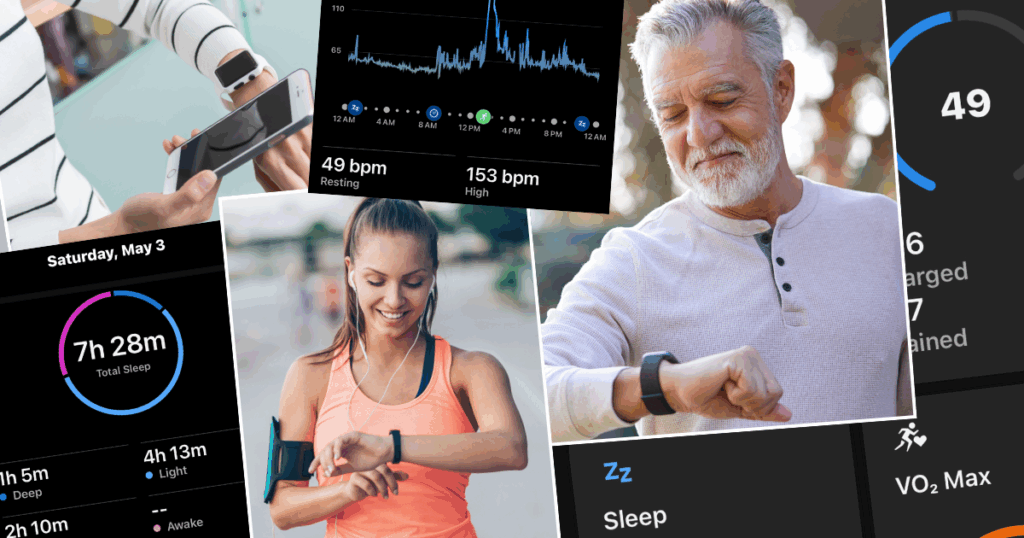Roughly one in three Americans now own wearable health tech, including smart watches, fitness trackers, and blood pressure monitors and biosensors. But as impactful as they can be, it’s important to be aware of what they can’t do, too. Otherwise, it’s easy to become overconfident when you see healthy heart rate and fitness scores, even though this doesn’t mean you can’t also have a buildup of plaque in your arteries.
Here’s a breakdown of what you can and can’t do with wearables, plus what you can do to fill in the gaps.
What you can track with wearables
You’re already somewhat familiar with wearable health tech — essentially any accessory you can wear on your skin and collect data, with the most popular options including the Apple Watch, FitBit watches and bands, and the Oura ring..
You can use these to keep an eye on:
- Heart rate. Most smartwatches and fitness trackers collect data like heart variability and resting heart rate (RHR), etc. Withings, a company selling a full range of hardware including scales and wearables, also has a subscription called Withings+ that leans heavily into cardio scores and check-ups.
- Blood sugar. You can use patches or plastic knobs to monitor blood sugar and capture real-time data after you eat. Some tracking apps issue real-time notifications to warn you if levels are too high or too low.
- Blood pressure. Watches, rings, and fitness trackers can digitally monitor blood pressure changes. Then, you can connect your data to a fitness app to look for changes or fluctuations linked to diet, sleep or exercise. And speaking of sleep…
- Sleep quality. There are dozens of tools offering sleep quality tracking, from Apple Watches and Oura Rings to earbuds and wrist bands. You can use these to track heart rate, respiration, body temperature, and movement to calculate a ‘sleep score’ that reflects your quality of rest.
- Cardio scores. Withings’ ScanWatch Light comes with a subscription to Withings+, and most of their smartwatches come with built-in ECGs to track your heart rate and rhythm for abnormalities.
This, of course, barely scratches the surface, as there are more and more wearables released every year and their capabilities continue to increase.
But there are a few things to keep in mind before leaning too heavily into the data.
A quick note on data accuracy
I’m a huge proponent of wearable tech devices. But that doesn’t mean there aren’t still issues to iron out.
I’m specifically talking about data accuracy. Taking wearables off, adjusting their location, and even working outside in extreme temperatures and humidity can negatively affect your vital readings.
You also have to consider different brands and different operating devices. Many calculate measurements in different ways, which can lead to discrepancies if you’re switching devices.
But the biggest issue is in estimation. We know some fitness devices tend to underestimate heart rate and burned calories, and step count. They can also overestimate sleep time, efficiency, and aerobic capacity. Some are more accurate than others, so make sure to do your research on which one is best suited to your goals.
To reiterate, I believe wearable tech is a phenomenal tool that can bring people closer to addressing their metabolic health. But it’s also essential to understand they still have limitations, and particularly when it comes to the things they cannot do (yet).
What you can’t track with wearables
Wearables can’t track every marker associated with metabolic health.
We still need traditional testing to keep an eye on:
- Nutritional content of blood. You can use wearables like CGMs and smart watches to keep an eye on your blood sugar and blood pressure. However, there’s no way to track nutrient content of the blood without collecting blood.
- Cholesterol and particle sizes. There’s been plenty of research in recent years on how to monitor blood lipids without traditional blood testing. Scientists are working on a public-facing product, but at this point in time, blood draws are really the best solution.
- Dietary patterns. A healthy metabolism is made in the kitchen. Unfortunately, wearables don’t really track this yet. There are some wearables available for automatic calorie counting, but tracking your actual nutrient intake will still depend on manual input.
- Body fat. One of the biggest underlying factors of poor metabolic health, especially your waist circumference (i.e., body fat). However, today’s wearables often struggle to give more accurate readings. They also can’t test waist circumference, which you can easily do at home with a tape measure and a string.
- C-reactive protein (CRP). Measuring CRP can help track inflammation in your body, which may indicate chronic disease like osteo-arthritis or autoimmune disorders like IBS. The only way to measure this currently is with a specialty lab order. You can learn more about what this looks like and how to get one in my guide to biomarkers for metabolic syndrome.
Again, wearable tech doesn’t have ways to track these metrics — yet. There are plenty of emerging technologies looking to push the boundaries of biomarkers and fitness tracking like muscle fatigue.
Just keep in mind these may be years in the making. Lab tests and at-home measurements are still the easiest way to get the full picture of your metabolic health.
Where you go from here
Wearables have completely transformed access to health information, and they’ve encouraged countless people to increase their daily movement, track some vital health markers, and improve their sleep. These are all excellent things.
But we should remember they are still an emerging technology that can’t always connect the dots between symptoms and solutions. They’re not capable of replacing lab tests, nor are they a true substitute for metabolic coaches, and certainly not enough to give a complete picture of your metabolic health (yet).
My advice is to use your wearables to track your activity levels, sleep scores, heart rate, and their other features. You’ll be able to get their baseline and then start making improvements.
Alongside that, a full picture of your health still requires data that wearables can’t provide. This means:
- Scheduling bi-yearly blood labs such as CBCs, CMPs, and advanced lipid tests
- Chatting with a metabolic health coach for help interpreting your numbers
- Tempering your numbers with recent research (like high cholesterol scores linked to being a lean mass hyper-responder)
Then, you can use labs, wearables, tracking apps, and other tools to decide what you need to do to improve your numbers.
Don’t forget to establish your baseline metrics first so you have a better idea of what you’re measuring against. If you haven’t already, you can get started today by taking my metabolic health quiz online.

Looking for the highest-quality meat from farmers who share your values?
I’m proud to partner with Route 22 Meats, where we connect health-conscious families with clean, sustainably raised meat from small family farms.
Your support doesn’t just bring premium cuts to your table. It helps empower local farmers, promote regenerative agriculture, and support a grassroots mission to improve food quality—and health—for all.
Explore our selection and experience the difference today.

